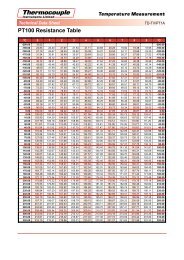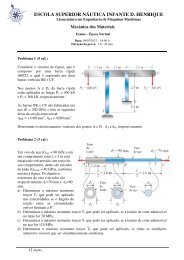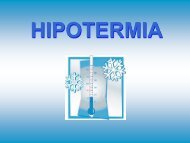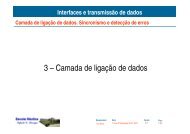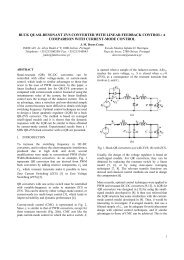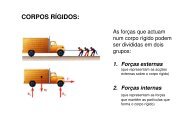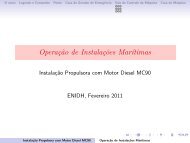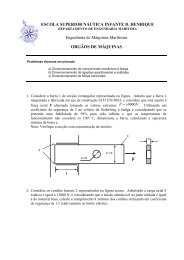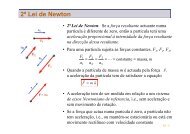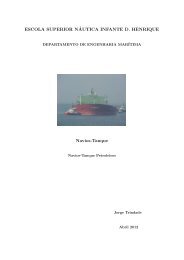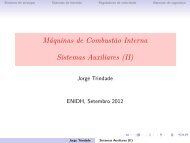Textos de Apoio (pdf)
Textos de Apoio (pdf)
Textos de Apoio (pdf)
Create successful ePaper yourself
Turn your PDF publications into a flip-book with our unique Google optimized e-Paper software.
Engine power, %R1<br />
100<br />
R1<br />
R1+<br />
Engine power, %R1<br />
100<br />
R1<br />
90<br />
R3<br />
90<br />
80<br />
R3<br />
Rx1<br />
Rx2<br />
Rating line<br />
slope = α<br />
80<br />
R4<br />
R2<br />
R2+<br />
70<br />
R4<br />
R2<br />
80<br />
90<br />
100<br />
Engine speed, %R1<br />
60<br />
70<br />
80<br />
90<br />
100<br />
Engine speed, %R1<br />
Fig. 2: For the RT-flex82C, RTA82C, RT-flex82T and<br />
RTA82T engines the layout fields are exten<strong>de</strong>d to the ratings<br />
R1+ and R2+ at the same powers as R1 and R2 respectively<br />
but with increased shaft speed.<br />
[08#049]<br />
that the lower CMCR speeds allow flexibility in<br />
selection of the optimum propeller with consequent<br />
benefits in propulsion efficiency and thus lower fuel<br />
consumption in terms of tonnes per day.<br />
One feature to be borne in mind when selecting<br />
the rating point for the <strong>de</strong>rated engine is the rating<br />
Fig. 4: Since the 1980s engine ratings have been selected over<br />
a steadily smaller area of the layout field.<br />
[08#051]<br />
Engine power, %R1<br />
100<br />
90<br />
80<br />
70<br />
60<br />
70<br />
R3<br />
R4<br />
Area of recent<br />
CMCR selection<br />
80<br />
Area of CMCR<br />
selection in<br />
the 1980s<br />
90<br />
R1<br />
100<br />
R2<br />
Engine speed, %R1<br />
Fig. 3: For a given ship, a rating line (slope α) can be applied<br />
to the layout field so that all rating points on that line would<br />
give the same ship speed with a suitably optimized propeller.<br />
Rating points at lower speeds on the rating line require<br />
a larger propeller diameter and give a greater propulsive<br />
efficiency.<br />
line (Fig. 3). This is the line through a CMCR rating<br />
point such that any point on the line represents<br />
a new power/speed combination that will give<br />
the same ship speed in knots. The points on the<br />
rating line all require the same propeller type but<br />
with different adaptations to suit the power/speed<br />
combination. In general, lower speeds of rotation<br />
require larger propeller diameters and thereby<br />
increase the total propulsive efficiency. Usually the<br />
selected propeller speed <strong>de</strong>pends on the maximum<br />
permissible propeller diameter. The maximum<br />
diameter is often <strong>de</strong>termined by operational<br />
requirements, such as <strong>de</strong>sign draught and ballast<br />
draught limitations, as well as class recommendations<br />
concerning propeller–hull clearance (pressure<br />
impulse induced by the propeller on the hull).<br />
The slope of the rating line (α) <strong>de</strong>pends broadly<br />
upon the ship type. It can range from 0.15 for<br />
tankers, bulk carriers and general cargo ships up to<br />
about 10,000 tdw to 0.22 for container ships larger<br />
than 3000 TEU and 0.25 for tankers and bulk<br />
carriers larger than 30,000 tdw.<br />
Changing engine selection strategies<br />
When the broad layout field was introduced in<br />
RTA engines in 1984 it was wi<strong>de</strong>ly welcomed by<br />
shipowners and shipbuil<strong>de</strong>rs. Afterwards RTA<br />
engines were frequently selected at ratings in the<br />
lower part of the layout field to gain the benefits of<br />
— 2 — © Wärtsilä Corporation, June 2008


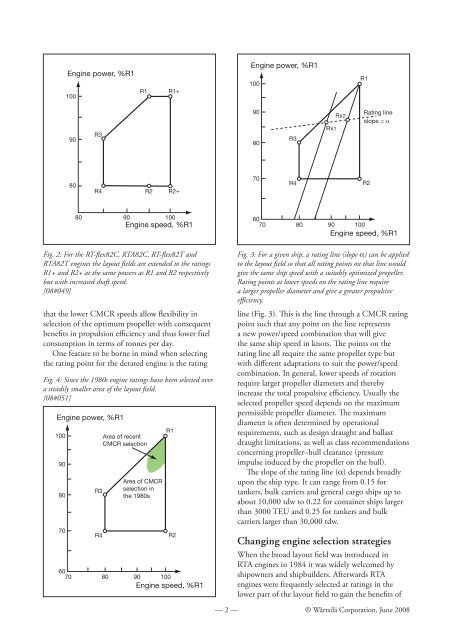
![Conceitos transmissao de dados .Sinais[.pdf]](https://img.yumpu.com/50982145/1/190x146/conceitos-transmissao-de-dados-sinaispdf.jpg?quality=85)
![Packages e interfaces[.pdf]](https://img.yumpu.com/50629553/1/190x134/packages-e-interfacespdf.jpg?quality=85)
